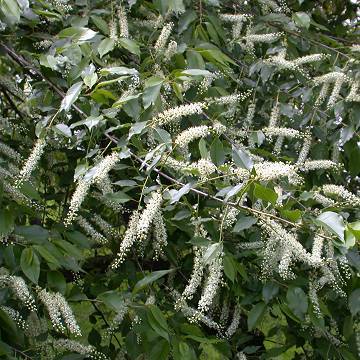

Prunus serotina - (image 1 of 6)
Taxonomy
Family: Rosaceae
Habitat
Common in woodlands, along fencerows and railroads.
Associates
In woodlands with Claytonia virginica, Cryptotaenia canadensis, Fraxinus americana, Galium aparine, Geranium maculatum, Osmorhiza claytonii, Parthenocissus quinquefolia, Podophyllum peltatum, Prunus virginiana, Quercus alba, Quercus rubra, Sanicula gregaria, Smilacina racemosa, Tilia americana, Vitis riparia.
Distribution
Most of the eastern half of US. In Canada from Nova Scotia and New Brunswick west to Southern Quebec. Also parts of Mexico and Central America.
Morphology
Deciduous tree to 100' high, pyramidal when young and developing a broad crown with age. Leaves alternate, simple, glossy, lanceolate to oblanceolate, at least twice as long as wide, often villous along midrib; teeth appressed or incurved, glandular. Young stems dark red-brown or black with horizontal gray lenticels; mature bark dark red-brown, exfoliating in plates, the lenticels still visible. Flowers white, more than 20, in elongate, ebracteate racemes; calyx lobes narrow, acute, entire or ambiguously glandular, persisting on the fruit. Fruit a round drupe, deep red-black, about 1cm in diameter, in drooping racemes.
Notes
Flowers early May to early June
Wetland indicator: Facultative Upland
The wood is hard, strong, light red-brown, and easily worked; highly valued for furniture and cabinet making. Fruits are relished by birds. They are also reputed to make good jams and preserves, although I have tried and the result was rather bitter. A rum or brandy flavored with wild black cherries is called "cherry bounce".
Fall color can range from yellow to orange-red. Not the most popular of trees for the landscape but better than many that are.
References
Dirr, Michael A. 1998. Manual of Woody Landscape Plants:
Their Identification, Ornamental Characteristics, Culture, Propagation and Uses.
5th ed. Champaign, Illinois: Stipes Publishing L.L.C.
Marquis, David A. 1990. Prunus serotina Ehrh. Black Cherry
In R.M. Burns and B.H. Honkala (eds.), Silvics of North America, Vol. 1,
Conifers, U.S.D.A.
For. Serv. Agric. Handbk. 654, Washington, D.C.
Swink, F. and G. Wilhelm. 1994. Plants of the Chicago Region.
Indiana Academy of Science. The Morton Arboretum. Lisle, Illinois.
|
Michael Hough © 2005 |